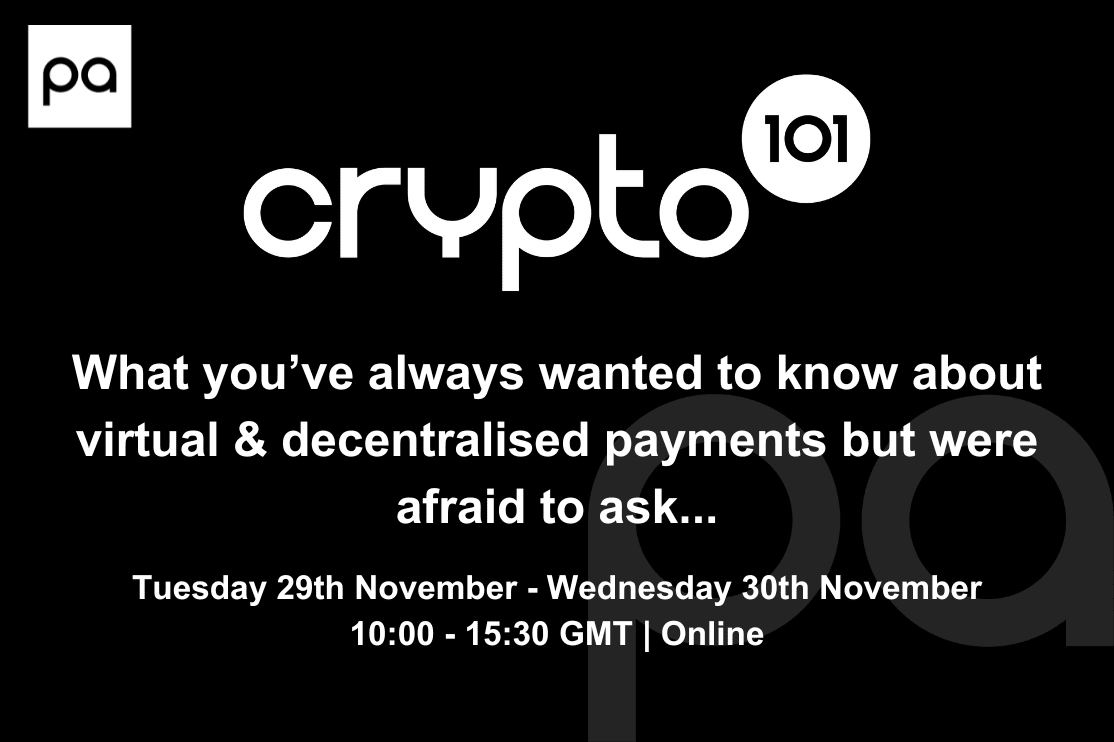

This broad and comprehensive overview of the fundamentals of virtual, crypto and decentralised payments gives an in-depth snapshot of this particular aspect of the payments industry for a better understanding of how it all fits together. The course combines presenter-led sessions, thought-provoking videos and quizzes. Drawing on real life examples, it weaves together the underpinning principles, key stakeholders and regulations. with practical applications for all three. It will bring an understanding of the key issues and opportunities, with practical advice to take back.
Pre-requisites
Payments 101 (or equivalent knowledge) is a pre-requisite, otherwise this course will be difficult to follow.
Regulations 101 (or equivalent knowledge) is desired (although not necessary), as it can help better understand the regulatory context.
Course Content Summary
START Registration and Introduction
PART 1 – DAY 1
INTRODUCTION: CENTRALISED vs DECENTRALISED
BLOCKCHAIN FUNDAMENTALS
DIGITAL/ VIRTUAL ASSETS (Part 1)
PART 2 – DAY 2
DIGITAL/ VIRTUAL ASSETS (Part 1)
TRANSACTING IN A DECENTRALISED PAYMENTS ECOSYSTEM
RISKS – AN OVERVIEW
REGULATIONS
MARKET OUTLOOK
CLOSE Final considerations
(Note: for the online courses, regular breaks are scheduled for mid-morning, lunch, as well as a number of frequent smaller breaks throughout).
Detailed Agenda
PART 1 – DAY 1
INTRODUCTION: CENTRALISED vs DECENTRALISED
Traditional payments ecosystem Recap (Cards & ACH)
Centralised vs distributed ledgers
BLOCKCHAIN FUNDAMENTALS
What is a Blockchain?
How does a blockchain work?
How are transactions validated?
Scalability & other issues
Governance & environmental impact
DIGITAL/ VIRTUAL ASSETS – PART 1
About money…
Virtual assets – Part 1
Virtual currencies
Crypto Assets
Crypto currencies
Stablecoins
Utility tokens
Security tokens
Smart contracts
Non-Fungible Tokens (NFTs)
PART 2 – DAY 2
DIGITAL/ VIRTUAL ASSETS – PART 2
Virtual assets – Part 2 (e-money, CBDC)
Market comparison & recap
Raising interest in virtual asset projects
TRANSACTING IN A DECENTRALISED PAYMENTS ECOSYSTEM
Digital wallets
Crypto exchanges
Recap on ecosystem actors
RISKS – AN OVERVIEW
Crypto asset risks
CBDC risks
REGULATIONS
Global regulatory landscape – AML
Crypto regulations – UK
Crypto regulations – Worldwide
MARKET OUTLOOK
The Metaverse, Web 2.0 vs Web 3.0
Payments: an evolving picture
Big Tech, upcoming use cases
Final considerations
 Course trainer: Neira Jones, FBCS, MsC
Course trainer: Neira Jones, FBCS, MsCNeira advises organisations of all sizes on payments, fintech, regtech, cybercrime, information security, regulations (e.g. PSD2, GDPR, AML) and digital innovation. More than 20 years in financial services and technology made her believe in change through innovation & partnerships. She always strives to demystify the hype surrounding current issues and also enjoys her work as an expert witness. She likes engaging on social media and regularly addresses global audiences as a keynote speaker or chair person.
For any questions or queries on the above course, feel free to reach out to Orlanna Morris on [email protected]